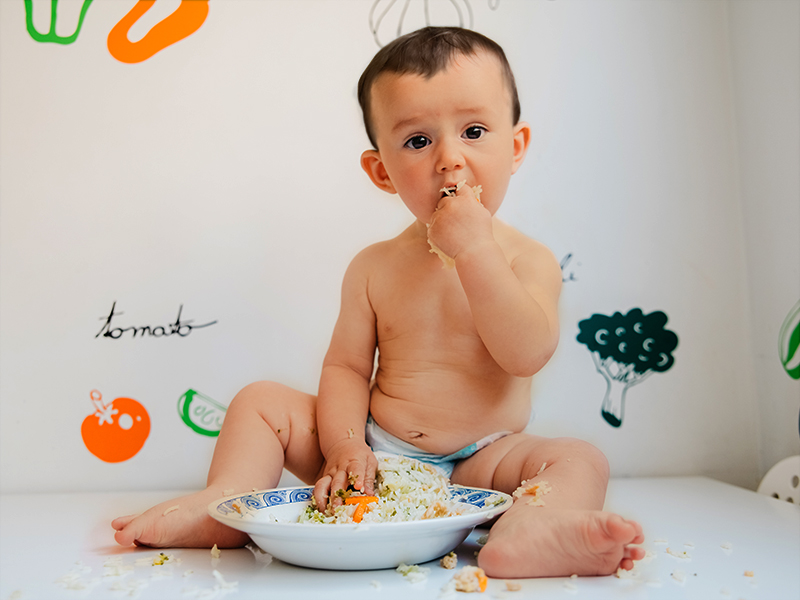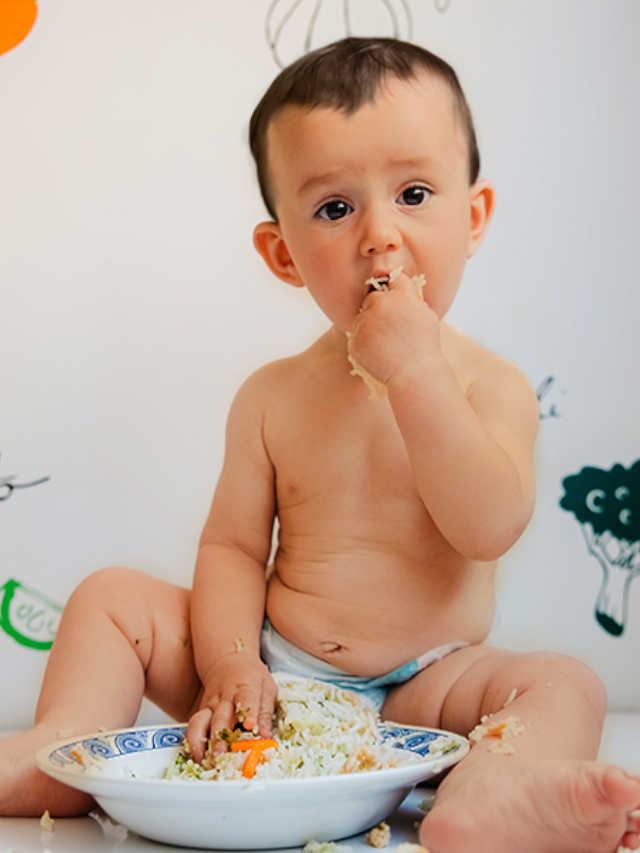For months your baby has thrived with just breast milk or formula on the menu. Now that your little one is getting bigger, he/she seems to want more out of lunch than mere milk. The first solid food for baby during the first year marks a milestone in his/her lifetime. It must be a challenging time for you (when is motherhood not!) to wean your baby off milk and you must be filled with a thousand questions in your head. When is the best time to introduce first food for baby? Which foods should come first? By the time your infant is 4 to 6 months old, you’ve probably got your breastfeeding or formula drill down to an art. Then comes a time when you will have to introduce solid food to your baby’s diet. In the beginning, you’ll have to experiment to find what works best. Here’s everything to know about starting a baby on solids, with tips about preparing the food.
6 Months Old: Time To Introduce Solid Food To Your Baby
When to start bay food? Paediatricians say that children can be introduced to foods other than breast milk or infant formula when they are about 6 months old. Every child is different. How do you know if your child is ready for foods other than breast milk or infant formula? You can look for these signs that your child is developmentally ready.
- Your child can sit with little or no support and has good head control
- Your child is curious, looking at everything around him/her, especially what you’re eating
- Your child opens his or her mouth and leans forward when food is offered
- Your child doesn’t push his tongue out at a spoon when you try to feed him
- Your child is still hungry after eating a good amount of breast milk or baby food
4 Signs That Your Baby Is Ready For Solid Food
The following signs in your baby generally indicates that he/she is passed the baby food stage and is ready for the first solid food for baby.
- When he/she stares at your food as a sign of showing interest in what you are eating
- When he/she reaches out his/her hands for your food; it implies that he/she is ready for baby led weaning
- When he/she has a good head and neck control and is able to sit upright when supported
- When he/she opens the mouth on being offered food with a spoon
Solid Weaning Foods You Can Start With
According to experts, your child can move over baby food and begin eating weaning foods at about 6 months old. It is not recommended that you initiate your baby to solid food before 4 months, which usually happens during baby led weaning. By the time he/she is 7 or 8 months old, your child can eat a variety of homemade baby food from different food groups. These best baby food include infant cereals (such as oat, barley, and multi-grain instead of only rice cereal), meat, iron rich foods for babies, or other proteins, fruits, vegetables, grains, yoghurts and cheeses, and more. once he/she has been initiated to solid food, you needn’t worry about when to start baby food.
Baby weaning is the process of stopping feeding your baby with breast milk. Here is some expert advice on making this process easier for new mothers.
1. Stewed Apple
Stewed apple is the first fruit that is introduced to babies. Apple is full of vitamins and nutrients, which help in a baby’s growth and development. Babies become more active day by day, so they need more energy and healthy nutrients for their growth and to fuel up their activities.
Method:
- Take a nice big red apple, peel its skin and cut it into small pieces.
- Boil it for 10-15 mins or till the time it is tender.
- Then grind it once it has cooled down.
- A tasty and healthy snack is ready!
- Start with giving your baby 1-2 pieces of the apple and gradually increase it to a full one.
Note: You can also prepare pears in a similar way.
2. Potato Cream
Once your baby completes six months of age, potatoes can be safely introduced as first food for baby. It’s one of the universally loved and expert-recommended vegetables that helps in healthy weight gain. Mashed potato is one of the best first baby foods for weaning babies who will love its soft, buttery texture and delicious taste.
Method:
- Take a medium-sized potato and boil it. Now put it in a mixer/grinder and churn it with 2 scoops of formula milk and ½ cup of water.
- Voila! The potato cream is ready. And babies actually love it!
Note: Introducing this food only when the baby is comfortable with solids is recommended. You can also add cooked Porridge to it to make it taste even better.
3. Banana Shake
This is one of the best baby food. Milkshakes are the tastiest and healthiest recipe to serve your child. And if it happens to be banana milkshakes, they are best for the teething phase and overall growth of your child. Also, this milkshake keeps your child full for a longer time and improves digestion as well. The soft and mushy texture of bananas makes them the most preferred food item for babies.
Method:
- Take a medium-sized ripe banana that does not have any black marks on its skin.
- Put it in a grinder and add 2 scoops of formula and 1/2 cup of water.
- Mix it and a healthy snack is ready for your baby.
4. Oats
Oats are a single-grain food that is easy on your baby’s digestive system. When it comes to starting your baby on solid foods, you can’t go wrong with oatmeal. It is a very nutritious food that is gentle on your baby’s digestive system and packed full of nutrients.
Method:
- Take 2 spoons of original oats and boil it in ½ cup of formula milk with ½ spoon of sugar.
- After giving it a good boil of 2-3 minutes, cool it down and grind it.
5. Semolina Kheer
Sooji Kheer for Babies is one of the easiest and most nutritious foods for your baby. It is easily digestible and tends to fill the tiny stomach and so sooji kheer for babies is a perfect food for dinner.
Method:
- Take half a teaspoon of ghee or butter, heat it and roast 1 spoon of semolina in it.
- Once it turns golden then add half a cup of water and let it simmer until it reaches desired consistency then you can add ½ cup of formula milk in the end.
6. Khichdi
This is a very healthy and tasty meal for babies. They simply seem to love it and you can make it more nutritious by adding veggies. Now you can not make khichdi with any daal. You need to keep the daal light so stick with moong dal and rice khichdi. You can add veggies like carrots, beans, potatoes and a drop of ghee too. thrown in a few pieces of brinjal to introduce him/her to iron-rich foods for babies.
Method:
- Take 3/4th cup of water, 1 tablespoon of rice and ½ tablespoon of moong dal.
- Put it in a pressure cooker. Cut 3 beans, an inch of carrot and half potato (about an inch) and add it to the pressure cooker.
- Add a pinch of turmeric (haldi) and ½ teaspoon of salt too.
- Switch off the gas after 3 whistles and let the steam pass out on its own.
- Grind it once it cools down and it is ready for your little one.
- You can also replace the rice with porridge (daliya) to give variety to your baby.
2 Baby Steps: How To Introduce Solid Food To Baby
Experts believe that introducing solids is more about getting babies used to chewing and swallowing food than providing any significant nutritional benefit. Let your child try one food at a time at first. This helps you see if your child has any problems with that food, such as food allergies. Wait for 3 to 5 days between each new food. Before you know it, your child will be on his or her way to eating and enjoying lots of new foods.
1. Check For Allergies
Paediatricians say that the eight most common allergenic foods are milk, eggs, fish, shellfish, tree nuts, peanuts, wheat, and soybeans. Generally, you do not need to delay introducing these foods to your child, but if you have a family history of food allergies, talk to your child’s doctor or nurse about what to do for your baby.
2. Try Small Quantities Of New Foods
Try offering baby very small quantities of food that is completely mashed or pureed, to begin with. Initially, a baby may have only as much as one teaspoonful. Here are some simple solid foods which can be easily given to a baby.
- Mashed or pureed vegetables like boiled potatoes or steamed carrot, broccoli, cauliflower and parsnip
- Mashed or pureed fruit, such as banana, a slice of soft peeled pear or mango. If you decide to give your baby an apple, do not give it in raw form. Make use of steamed apples for feeding an infant
- Baby cereal such as baby rice, cornmeal, sago or millet
5 Food To Be (Or Not To Be) Given To Your Baby
- Give your baby completely pureed food. The consistency should be runny for all foods to avoid choking
- Always start with solids on a spoon and never put solids in a bottle
- Breast milk and formula are still important, but give your baby solids before them to encourage him/her to accept new foods
- Mix cereals and mashed cooked grains with breast milk, formula, or water to make it smooth and easy for your baby to swallow
- Remove all fat, skin, and bones from poultry, meat, and fish, before cooking
8 Tips on How To Avoid Choking
- Remove seeds and hard pits from the fruit and then cut the fruit into small pieces
- Cut soft food into small pieces or thin slices
- Cut cylindrical foods like hot dogs, sausage and string cheese into short thin strips instead of round pieces that could get stuck in the airway
- Cut small spherical foods like grapes, cherries, berries and tomatoes into small pieces
- Cook and finely grind or mash whole-grain kernels of wheat, barley, rice, and other grains
- Mash or puree vegetables, fruits and other foods until they are smooth
- Hard fruits and vegetables, like apples and carrots, usually need to be cooked so they can be easily mashed or pureed
- Cook food until it is soft enough to easily mash with a fork
As your baby adjusts to eating solids, know that there may be days when they’re more interested in peas and carrots than in the breast or bottle and, on the flip side, days when all they’ll want to do is nurse. This is all normal as your baby begins to grow more independent, but for now, they still need their normal day’s worth of breast milk or formula. As soon as your little one understands the concept of eating and shows interest in mealtime, start them on a routine for breakfast, lunch, and dinner. Even if they aren’t hungry at times, they’ll get used to the idea of eating on a schedule. Don’t put too much pressure on yourself, this is going to be a great journey with your baby!












